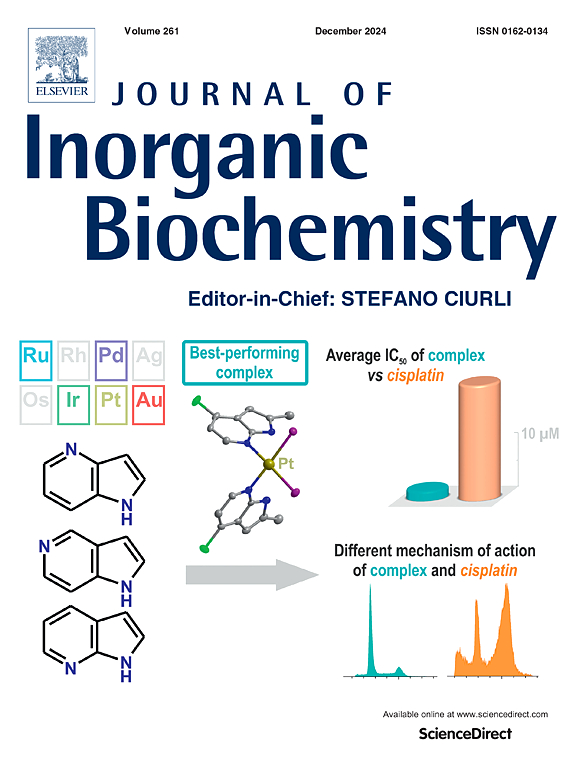六种肉桂酸三环己基锡配合物的合成及其抗癌活性
IF 3.2
2区 化学
Q2 BIOCHEMISTRY & MOLECULAR BIOLOGY
引用次数: 0
摘要
成功合成了6个肉桂酸锡三环己基配合物(C1 ~ C6),并对其进行了表征。测定了C1、C2、C4和C5的晶体结构。其中配合物C1、C2和C5通过SnO相互作用或O- h…O氢键形成一维无限链结构。所有复合物对人类癌细胞株A549、HepG2和MDA-MB-231的抑制活性进行了测试。结果表明,C2复合物对HepG2细胞的抑制作用最为显著,IC50值为1.31±0.47 μM。初步研究表明,C2复合物诱导HepG2细胞线粒体膜电位降低,通过线粒体途径引发细胞凋亡,并伴有G2期细胞周期阻滞。利用紫外可见、荧光竞争和分子对接等方法对C2的DNA结合活性进行了研究,发现C2可以有效嵌入DNA凹槽。本文章由计算机程序翻译,如有差异,请以英文原文为准。

Synthesis and anticancer activity of six tricyclohexyltin cinnamate complexes
Six tricyclohexyl tin cinnamate complexes (C1 ∼ C6) were successfully synthesized and were characterized. The crystal structures of C1, C2, C4, and C5 were determined. Among them, complexes C1, C2 and C5 form a one-dimensional infinite chain structure through Sn![]() O interactions or O-H…O hydrogen bonds. All complexes were tested for their inhibitory activity against human cancer cell lines A549, HepG2, and MDA-MB-231. The results showed that the C2 complex demonstrated the most significant inhibitory effect on HepG2 cells, with an IC50 value of 1.31 ± 0.47 μM. Preliminary studies indicate that the C2 complex induces a reduction in mitochondrial membrane potential in HepG2 cells, triggering apoptosis via the mitochondrial pathway accompanied by cell cycle arrest at the G2 phase. The DNA binding activity of C2 was investigated using ultraviolet-visible, fluorescence competition assays and molecular docking, revealing that C2 can effectively intercalate the DNA groove.
O interactions or O-H…O hydrogen bonds. All complexes were tested for their inhibitory activity against human cancer cell lines A549, HepG2, and MDA-MB-231. The results showed that the C2 complex demonstrated the most significant inhibitory effect on HepG2 cells, with an IC50 value of 1.31 ± 0.47 μM. Preliminary studies indicate that the C2 complex induces a reduction in mitochondrial membrane potential in HepG2 cells, triggering apoptosis via the mitochondrial pathway accompanied by cell cycle arrest at the G2 phase. The DNA binding activity of C2 was investigated using ultraviolet-visible, fluorescence competition assays and molecular docking, revealing that C2 can effectively intercalate the DNA groove.
求助全文
通过发布文献求助,成功后即可免费获取论文全文。
去求助
来源期刊

Journal of Inorganic Biochemistry
生物-生化与分子生物学
CiteScore
7.00
自引率
10.30%
发文量
336
审稿时长
41 days
期刊介绍:
The Journal of Inorganic Biochemistry is an established international forum for research in all aspects of Biological Inorganic Chemistry. Original papers of a high scientific level are published in the form of Articles (full length papers), Short Communications, Focused Reviews and Bioinorganic Methods. Topics include: the chemistry, structure and function of metalloenzymes; the interaction of inorganic ions and molecules with proteins and nucleic acids; the synthesis and properties of coordination complexes of biological interest including both structural and functional model systems; the function of metal- containing systems in the regulation of gene expression; the role of metals in medicine; the application of spectroscopic methods to determine the structure of metallobiomolecules; the preparation and characterization of metal-based biomaterials; and related systems. The emphasis of the Journal is on the structure and mechanism of action of metallobiomolecules.
 求助内容:
求助内容: 应助结果提醒方式:
应助结果提醒方式:


